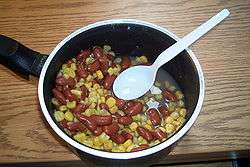Succotash
Succotash (from Narragansett sohquttahhash, "broken corn kernels"[1][2]) is a culinary dish consisting primarily of sweet corn with lima beans or other shell beans. Other ingredients may be added including corned beef, potatoes, turnips, salt pork, tomatoes, multi-colored sweet peppers, and okra.[3][4] Combining a grain with a legume provides a dish that is high in all essential amino acids.[5][6] Because of the relatively inexpensive and more readily available ingredients, the dish was popular during the Great Depression in the United States. It was sometimes cooked in a casserole form, often with a light pie crust on top as in a traditional pot pie. Succotash is a traditional dish of many Thanksgiving celebrations in New England,[7] as well as in Pennsylvania and other states. In some parts of the American South, any mixture of vegetables prepared with lima beans and topped with lard or butter is called succotash. Corn (maize), American beans, tomatoes, and peppers are New World foods.
.jpg) Succotash with corn, lima beans, carrots, and other vegetables. | |
| Course | Main course |
|---|---|
| Place of origin | United States and Canada |
| Serving temperature | Hot |
| Main ingredients | Sweet corn, lima beans, butter, salt |

See also
- A Key Into the Language of America
- List of legume dishes
- List of maize dishes
- List of regional dishes of the United States
References
- Trumbull, James Hammond (1903). Natick Dictionary. Bulletin 25. Washington: Smithsonian Institution, Bureau of American Ethnology. Entry for sohquttahham (page=152; archive page n190).
v.t. he breaks (it) in small pieces, pounds (it) or beats (it) small. The formative tahum according to Howse (Cree Gr. 86), 'implies he beats or batters the object, after the manner of the root.' Inan. pl. sohquttahhamunash, they (grains of corn, Is. 28,28) are broken; otherwise s?hq-, sukq-. Adj. and adv. sohquttahhae, pounded; pl. sohquttahhash, whence the adopted name, succotash. Cf. pohqunnum. [Cree séekwa-tahúm, he beats it into smaller pieces.]
- Trumbull (1903). Entry for *msickquatash (p. 67; archive p. n194): (Narr.) n.pl. 'boiled corn whole' (i.e. mo-soquttahhash, not broken small or pounded?). See soh-quttahham. When broken, soquttahhash without the prefix. Hence the common name succotash, improperly applied, however, to the unbroken corn.
- "succotash". The American Heritage Dictionary of the English Language (4 ed.). Houghton Mifflin Company. 2004. Retrieved 2009-02-21.
- Bowles, Ella Shannon (1947). Secrets of New England Cooking. Barrows.
- Annigan, Jan. "Nutritional Sources of Essential Amino Acids". Retrieved 5 June 2017.
- "Essential Amino Acids". hyperphysics.phy-astr.gsu.edu. Retrieved 5 June 2017.
- Morgan, Diane and John Rizzo. The Thanksgiving Table: Recipes and Ideas to Create Your Own Holiday Tradition. Pg. 122.
Further reading
- Harper Fussell, Betty (2004). The Story of Corn. UNM Press. pp. 184–185. ISBN 0-8263-3592-6.